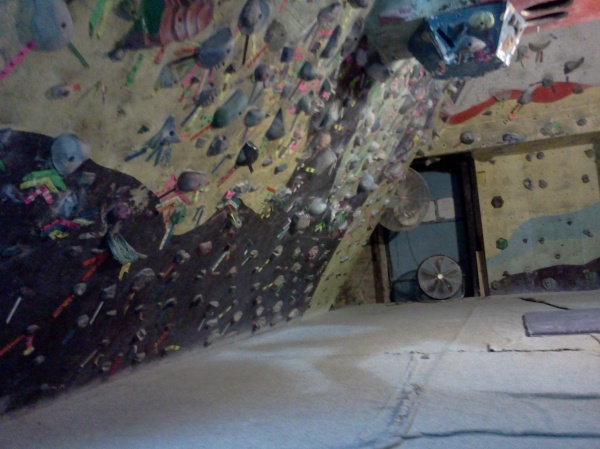Juniper commented on my post the other day that she doesn’t think there are enough routes in her small gym to try out the training wheels for training workout I stole from Kris at Power Company Climbing. So for Juniper and everyone else, here’s a whole post about how I got into ‘setting’ my own routes at the gym.
Inventing or setting routes is a learned skill that gets better with practice!
Basic Method
- Look – Find hold(s) on the wall that you want to use! This is the fun part! Pick anything that appeals to you.
- Sequence – Make up a sequence that will take you from the ground to the top, using the hold you picked
- See – Visualize the movement of the sequence. Decide which hands will go on which holds, think about the feet. What will your body look like at various points on the route?
- Climb – Climb your new route and see how it feels.
- Revise & Repeat – Think about what you’ve just climbed. Was something to hard or too easy, too close or to far?
When you first start, it can be hard to visualize movement accurately, or to remember all the holds you’ll need (without the visual cue of tape). This is ok! Do as much as you can. Here are some ideas that will let you practice routesetting skills and movement visualization which aren’t as memory-intensive as making up a new route from scratch.
First Steps: Modifications to Existing Routes
These are the easiest ways to make up your own routes (in order of increasing difficulty). Routesetting for yourself can be a great tool to prevent warmups and other climbs you repeat regularly from becoming stale.
- Track Feet – on easier routes (think warm-ups) can you use tracking feet only? Why or why not? What foot (feet) are absolutely essential?
- Links – take two different routes and find a way to link them together, using holds on the routes themselves or by adding extra holds.
- Delete – can you climb a route without using all the holds? Which ones can be removed?
- Replace – take a hold on an existing route, declare it off bounds, and replace it with another hold. Does it make the route easier or harder? This can help get you familiar with hold types you avoid–replace a jug with a sloper or a pinch on a warm-up, for example.
Making Up New Routes Using the Holds that are Already on the Wall
The easiest way to start making up whole new routes is to pick a sequence of hand-holds, leaving the feet open. This way, you have fewer things to remember. To get the most out of it, it’s best to plan, visualize, and then climb, instead of adding holds one by one to the route.

Walls with high hold density tend to work best for making up problems. This is the 45deg wall at the gym where I train–it was crazy empty the day I took this picture!
Sometimes I pick a start hold and ‘build’ the sequence in my head from the ground up. Sometimes I pick a hold (often part of a route that’s too hard for me, or one that addresses a weakness (bad crimps, pinches, slopers)) and make up a way to get to it instead. Sometimes I just decide the general path I want to take, for example, all the way across the base of the 45 and then up. Or sometimes I want to find holds that put my body into a cool position. It’s up to you!
How to Make Your Routes Better
If you’ve made up routes before, but didn’t like them, keep trying! For some ideas, check out posts over at Power Company Climbing, one consisting of tips from Kris, and another which is a truly awesome interview with Chris Danielson, including his thoughts on Kris’s tips! Here are some things I do to make my own routes better…
- Find a friend: It’s much more fun to work on making a route with another person than by yourself. It’s more fun to discuss how a route climbs or how movement feels out loud than in your own head.
- Practice: Then practice some more. This makes a huge difference in the quality of the routes you invent. If you keep at it, you will see improvement, and feel it in the way your routes climb.
- Break the ladder: Routes that climb like ladders–left, right, left, right, hand, foot, hand foot, all the way up are boring! Try setting routes that traverse, or set a bump move. Find ways to break the pattern, and your routes will become more interesting.
- Specify Feet: Take off the good ones, or allow feet only of a certain color. This requires you to keep more information about the route in your head, but will add another complex and interesting dimension to your routesetting.
Finally, remember that the folks that set routes work from a place of powerful passion for climbing and love of movement–which, as a climber you already have. You already have what it takes to ‘set’ your own routes.
But, I climb 3 – 4 nights a week, and EVERY time I climb I am routesetting. No matter where I am climbing or what gym I go to, I am always creating boulders based on existing holds on the wall. For me, this is, without question, the best way to better understand how to create movement, and also understand the movement itself better. On your gym’s wall, or a home woodie, with enough density of holds, you can make up a dozen or more new climbs every night. — Chris Danielson, interviewed by Power Company Climbing, in a post you should go read right now

Hey there, thanks for addressing my comment. Will write more once I have time!